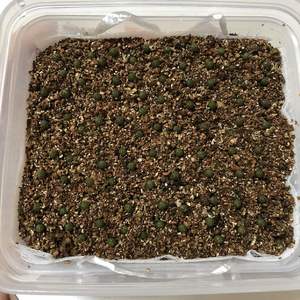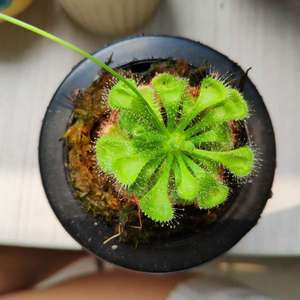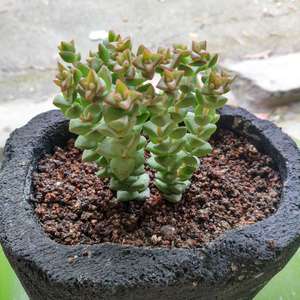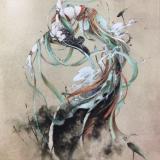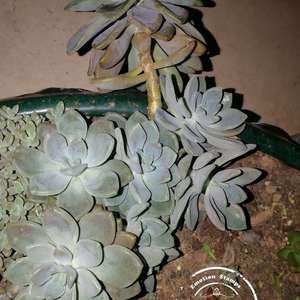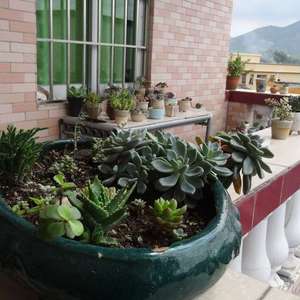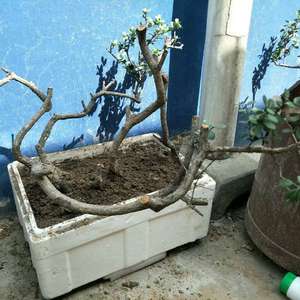成长记
choya8684
2018年07月04日

之前梅雨季攤開的葉片最近開始向內彎,很耐曬,但下葉一直枯黃,到底是缺水還是因爲下葉幾乎蓋住土表所以悶到?不過下葉掉完自然就不會悶了吧XD。然後下面藏了3個見不得光的孩子
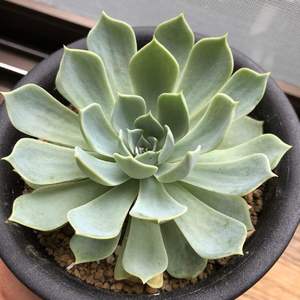

0
0
文章
Miss Chen
2018年07月03日

Description: This annual plant is ½–2' tall, and usually unbranched. The central stem has lines of fine white hairs, or is glabrous. The alternate leaves are up to 3½" long and 1" across, with long narrow petioles that are slightly hairy. They are lanceolate or ovate, with bluntly serrated margins and conspicuous pinnate venation. There is a tendency for the leaves to congregate together near the top of the central stem, or any side stems that may be present. Where the petiole of each leaf meets the stem, there is a conspicuous bract that wraps around the inflorescence consisting of a green cyathium. This bract is slightly ciliate along the edges, and has 5-9 lobes. The cyathium contains tiny staminate and pistillate flowers without sepals and petals. The staminate flower is covered with yellow pollen, while the pistillate flower produces a 3-lobed spheroid fruit that is typical of the spurges. Each fruit contains three seeds. The blooming period occurs from about mid-summer until frost during the fall, and lasts one or more months. There is no floral scent. The root system consists of a central taproot.
Cultivation: The preference is light shade to full sun, and moist to slightly dry conditions. This plant often grows in fertile, loamy soil, but can tolerate gravelly or clay soil as well. This plant is easy and undemanding, and may volunteer spontaneously in a wildflower garden or ecological restoration. However, it is rather common and weedy.
Range & Habitat: The native Rhomboid Mercury occurs in every county of Illinois, and it is quite common (see Distribution Map). This is a rather inconspicuous plant that is easily overlooked because of the lack of showy flowers. Habitats include disturbed areas of moist prairies, limestone glades, openings or lightly shaded areas of floodplain forests, thickets, seeps, stream banks, ditches, fields, fence rows, roadsides, areas along railroads, vacant lots, poorly maintained lawns and gardens, and waste areas. This plant prefers moist disturbed areas.
Faunal Associations: Like other members of the Spurge family that occur in Illinois, the seeds are attractive to such birds as the Mourning Dove and Greater Prairie Chicken; they may also be attractive to the Bobwhite, Horned Lark, and Wild Turkey. The herbaceous Acalypha spp. in Illinois lack the poisonous white latex of other members in the Spurge family, and their foliage is probably less toxic as a result. Deer are known to browse on Acalypha spp. occasionally, and it is possible that other mammalian herbivores do this as well. There have been reports of cattle being poisoned by these plants, possibly because of accumulation of nitrates in the foliage. It is unclear to me if the flowers of Acalypha spp. are wind- or insect-pollinated, although I suspect the former.

Photographic Location: The photographs were taken in a front yard along a roadside near Urbana, Illinois.
Comments: There are several Acalypha spp. in Illinois; the number of seeds per fruit can range from 1 to 3 (usually the latter), depending on the species. The species described here, Acalypha rhomboidea, is very similar to Acalypha virginica, except that the latter has 9-15 lobes in the bract that surrounds the inflorescence at the base of the petiole. Some authorities consider the former species to be merely a variety of the latter. The foliage of Acalypha spp. often becomes purplish tan during the fall, which has inspired the common name, 'Copperleaf.' This common name is often used in the agricultural industry.
Cultivation: The preference is light shade to full sun, and moist to slightly dry conditions. This plant often grows in fertile, loamy soil, but can tolerate gravelly or clay soil as well. This plant is easy and undemanding, and may volunteer spontaneously in a wildflower garden or ecological restoration. However, it is rather common and weedy.
Range & Habitat: The native Rhomboid Mercury occurs in every county of Illinois, and it is quite common (see Distribution Map). This is a rather inconspicuous plant that is easily overlooked because of the lack of showy flowers. Habitats include disturbed areas of moist prairies, limestone glades, openings or lightly shaded areas of floodplain forests, thickets, seeps, stream banks, ditches, fields, fence rows, roadsides, areas along railroads, vacant lots, poorly maintained lawns and gardens, and waste areas. This plant prefers moist disturbed areas.
Faunal Associations: Like other members of the Spurge family that occur in Illinois, the seeds are attractive to such birds as the Mourning Dove and Greater Prairie Chicken; they may also be attractive to the Bobwhite, Horned Lark, and Wild Turkey. The herbaceous Acalypha spp. in Illinois lack the poisonous white latex of other members in the Spurge family, and their foliage is probably less toxic as a result. Deer are known to browse on Acalypha spp. occasionally, and it is possible that other mammalian herbivores do this as well. There have been reports of cattle being poisoned by these plants, possibly because of accumulation of nitrates in the foliage. It is unclear to me if the flowers of Acalypha spp. are wind- or insect-pollinated, although I suspect the former.

Photographic Location: The photographs were taken in a front yard along a roadside near Urbana, Illinois.
Comments: There are several Acalypha spp. in Illinois; the number of seeds per fruit can range from 1 to 3 (usually the latter), depending on the species. The species described here, Acalypha rhomboidea, is very similar to Acalypha virginica, except that the latter has 9-15 lobes in the bract that surrounds the inflorescence at the base of the petiole. Some authorities consider the former species to be merely a variety of the latter. The foliage of Acalypha spp. often becomes purplish tan during the fall, which has inspired the common name, 'Copperleaf.' This common name is often used in the agricultural industry.
0
0
文章
Miss Chen
2018年06月29日

Spike of FlowerheadsDescription: This perennial plant is 2-5' tall and unbranched. The central stem is light green to purplish green, terete or slightly ridged, and glabrous to sparsely pubescent. The alternate leaves are up to 10" long and about 1/3" (8 mm.) across, becoming smaller as they ascend the stem. Because of their dense distribution, they appear almost whorled. The leaves are linear in shape and their margins are smooth (entire). Each leaf has a distinct central vein. Both the upper and lower leaf surfaces are light to medium green and glabrous to sparsely hairy. The central stem terminates in a wand-like spike of flowerheads about 4-18" in length. These flowerheads are densely crowded along the spike, facing in all directions; they bloom at the top of the spike first, opening later below. Each flowerhead is about 1/3" (8 mm.) across, consisting of 4-10 disk florets and no ray florets. The corolla of each disk floret is pink to purplish pink (rarely white) and narrowly tubular. The upper corolla divides in 5 small lobes that are lanceolate in shape and somewhat recurved. A deeply divided style is strongly exerted from the corolla; it is white to light pink, filiform, and sometimes slightly twisted or curved. Around the base of each flowerhead, there are appressed floral bracts (phyllaries) that are overlapping. These floral bracts are green to purple, glabrous, and oval in shape. The blooming period occurs from mid- to late summer, lasting about 3 weeks. There is no noticeable floral scent. Afterwards, the florets are replaced by small achenes with stiff bristles at their apices; these bristles are light brown. The root system consists of a corm with shallow fibrous roots. Colonies of plants are often formed by means of clonal offsets that involve the production of new corms.
Cultivation: The preference is full sun, moist conditions, and sandy loam. Other soil types, such as loam and gravelly loam, are readily tolerated in cultivation. The soil should possess sufficient organic material to retain moisture. The height of this plant can vary considerably, depending on its maturity, soil moisture, and soil fertility. During hot dry weather, the lower leaves may wither away, otherwise this plant presents few problems.
Range & Habitat: The native Marsh Blazingstar occurs in NE Illinois and a few scattered counties elsewhere (see Distribution Map). It is an uncommon plant in the wild. Habitats include moist black soil prairies, moist sand prairies, prairie swales, edges of marshes and bogs, grassy fens, calcareous seeps, moist alkaline sandflats, and areas along railroads. This blazingstar is found primarily in higher quality natural areas, especially where it is sandy.

Faunal Associations: The flowerheads are cross-pollinated by bumblebees, long-horned bees (Melissodes spp.), leaf-cutting bees (Megachile spp.), butterflies, and skippers. These insects suck nectar, although some of the bees also collect pollen for their larvae. Two uncommon prairie insects feed on Liatris spp. (blazingstars): caterpillars of Schinia sanguinea (Liatris Flower Moth) feed on the florets and developing seeds, while caterpillars of Carmenta anthracipennis (Liatris Borer Moth) bore through the stems. Mammalian herbivores eat this and other blazingstars readily; groundhogs and rabbits favor younger plants, while deer and livestock are more likely to browse on mature plants. The corms are eaten by the Prairie Vole and Meadow Vole. An overpopulation of these animals can make the establishment of this plant difficult in some areas.
Photographic Location: The photographs were taken at a moist prairie in Meadowbrook Park, Urbana, Illinois.

Comments: Marsh Blazingstar is a very attractive plant while in bloom, resembling a magic wand. It is more common in flower gardens than in the wild, although some cultivated plants may be hybrids with similar species. Among the various Liatris spp. (blazingstars) that are native to Illinois, Prairie Blazingstar (Liatris pycnostachya) probably resembles Marsh Blazingstar the most. However, this latter plant has floral bracts (phyllaries) that are strongly recurved, while the floral bracts of Marsh Blazingstar are appressed together and relatively smooth. Other blazingstars within the state are either shorter in height or they have larger flowerheads with more disk florets per head. While other blazingstars are typically found in mesic prairies and various upland habitats, Marsh Blazingstar is unusual in its preference for wetter habitats.
Cultivation: The preference is full sun, moist conditions, and sandy loam. Other soil types, such as loam and gravelly loam, are readily tolerated in cultivation. The soil should possess sufficient organic material to retain moisture. The height of this plant can vary considerably, depending on its maturity, soil moisture, and soil fertility. During hot dry weather, the lower leaves may wither away, otherwise this plant presents few problems.
Range & Habitat: The native Marsh Blazingstar occurs in NE Illinois and a few scattered counties elsewhere (see Distribution Map). It is an uncommon plant in the wild. Habitats include moist black soil prairies, moist sand prairies, prairie swales, edges of marshes and bogs, grassy fens, calcareous seeps, moist alkaline sandflats, and areas along railroads. This blazingstar is found primarily in higher quality natural areas, especially where it is sandy.

Faunal Associations: The flowerheads are cross-pollinated by bumblebees, long-horned bees (Melissodes spp.), leaf-cutting bees (Megachile spp.), butterflies, and skippers. These insects suck nectar, although some of the bees also collect pollen for their larvae. Two uncommon prairie insects feed on Liatris spp. (blazingstars): caterpillars of Schinia sanguinea (Liatris Flower Moth) feed on the florets and developing seeds, while caterpillars of Carmenta anthracipennis (Liatris Borer Moth) bore through the stems. Mammalian herbivores eat this and other blazingstars readily; groundhogs and rabbits favor younger plants, while deer and livestock are more likely to browse on mature plants. The corms are eaten by the Prairie Vole and Meadow Vole. An overpopulation of these animals can make the establishment of this plant difficult in some areas.
Photographic Location: The photographs were taken at a moist prairie in Meadowbrook Park, Urbana, Illinois.

Comments: Marsh Blazingstar is a very attractive plant while in bloom, resembling a magic wand. It is more common in flower gardens than in the wild, although some cultivated plants may be hybrids with similar species. Among the various Liatris spp. (blazingstars) that are native to Illinois, Prairie Blazingstar (Liatris pycnostachya) probably resembles Marsh Blazingstar the most. However, this latter plant has floral bracts (phyllaries) that are strongly recurved, while the floral bracts of Marsh Blazingstar are appressed together and relatively smooth. Other blazingstars within the state are either shorter in height or they have larger flowerheads with more disk florets per head. While other blazingstars are typically found in mesic prairies and various upland habitats, Marsh Blazingstar is unusual in its preference for wetter habitats.
0
0
文章
Miss Chen
2018年06月28日

Description: This herbaceous perennial wildflower is usually an emergent aquatic that is exerted 1-3' above the water line, otherwise it is a terrestrial plant of similar height. The stems are usually unbranched, although larger plants are sometimes branched below. The stems are light green, angular-terete, and glabrous. At intervals along each stem, there are pairs of opposite leaves about 2-6" long and ¼-1" across that are either sessile or short-petioled. The deciduous leaves are narrowly lanceolate, linear-lanceolate, elliptic, or narrowly elliptic in shape and usually smooth along their margins. Less often, the outer margins may be slightly undulate or shallowly crenate. Both the upper and lower surfaces of the leaves are medium green and glabrous.
From the axils of the middle to upper leaves, there develops individual spikes of flowers on long peduncles. Each floral spike is about 1" long and capitate (head-like) in appearance; there are several overlapping flowers and buds per spike. Each flower is about ¾" across, consisting of a short-tubular corolla with 4 lobes, a short-tubular calyx with 5 teeth, 2 stamens with dark purple or dark brown anthers, and an ovary with a slender white style. The corolla has a shallowly notched upper lobe that curves backward, 2 lateral lobes that are widely spreading, and a lower lobe that curves slightly downward. Except for the dark purple mottling at the base of the lower lobe, the lobes are mostly white, otherwise they are tinted pale purple or they are lightly speckled with fine purple dots. The lobes of the corolla are longer than the corolla tube, and they are oblong to oblong-oblanceolate in shape. The green calyx is about ¼" long and glabrous; its teeth are narrowly lanceolate. The ascending straight peduncles are a little shorter to about as long as the leaves (up to 6" in length); they are medium green, angular, and glabrous. The blooming period occurs from early summer into the fall, lasting about 2-4 months. Usually, only a few flowers are in bloom at the same time. Afterwards, the flowers are replaced by seed capsules up to ½" long that taper to stipe-like bases. Each capsule has 2 cells, and each cell contains 2 seeds. The seeds are about 1/8" (3 mm.) in length and warty. The root system is highly rhizomatous, forming colonies of plants.

Cultivation: The preference is full or partial sun, shallow standing water (up to 3' deep) or wet conditions, and soil that is muddy, sandy, or gravelly.
Range & Habitat: The native Water Willow is occasional in most areas of Illinois, except the NW section of the state, where it is uncommon or absent (see Distribution Map). Habitats include sandbars, gravelbars, or mudbars of rivers, low islands in rivers or ponds, shallow water or muddy banks of ponds and rivers, shallow water of rocky upland streams, shallow water or wet areas of swamps, and sandy marshes. Water Willow occurs in wetlands with either stagnant water or slow to moderate currents of water.
Faunal Associations: The flowers are cross-pollinated primarily by bees, including honeybees, bumblebees, Anthophorine bees (Anthophora spp.), little carpenter bees (Ceratina spp.), cuckoo bees (Epeolus spp., Triepeolus spp.), long-horned bees (Melissodes spp., Synhalonia spp.), leaf-cutter bees (Megachile spp.), green metallic bees, and other Halictid bees. Other floral visitors include various wasps, bee flies (Bombyliidae), thick-headed flies (Conopidae), Syrphid flies (non-pollinating), small butterflies, and skippers. These insects obtain primarily nectar from the flowers, although some bees collect pollen and some flies feed on pollen. Water Willow is one of the host plants for the caterpillars of Darapsa versicolor (Hydrangea Sphinx); they feed on the foliage. This plant is also a minor source of food for muskrats.

Photographic Location: A sandy marsh at the Heron Boardwalk in Vermilion County, Illinois.
Comments: The flowers of Water Willow are fairly showy and bloom intermittently for a long period of time. In spite of its common name, this is a non-woody herbaceous plant that is not closely related to willows (Salix). Water Willow is the most northern member of its genus. Another species that can be found in southern Illinois, Justicia ovata (Southern Water Willow), is a slightly smaller plant with wider leaves and more loosely flowered spikes. Otherwise, these two species have a similar appearance and prefer similar habitats. A scientific synonym of Water Willow is Dianthera americana.
From the axils of the middle to upper leaves, there develops individual spikes of flowers on long peduncles. Each floral spike is about 1" long and capitate (head-like) in appearance; there are several overlapping flowers and buds per spike. Each flower is about ¾" across, consisting of a short-tubular corolla with 4 lobes, a short-tubular calyx with 5 teeth, 2 stamens with dark purple or dark brown anthers, and an ovary with a slender white style. The corolla has a shallowly notched upper lobe that curves backward, 2 lateral lobes that are widely spreading, and a lower lobe that curves slightly downward. Except for the dark purple mottling at the base of the lower lobe, the lobes are mostly white, otherwise they are tinted pale purple or they are lightly speckled with fine purple dots. The lobes of the corolla are longer than the corolla tube, and they are oblong to oblong-oblanceolate in shape. The green calyx is about ¼" long and glabrous; its teeth are narrowly lanceolate. The ascending straight peduncles are a little shorter to about as long as the leaves (up to 6" in length); they are medium green, angular, and glabrous. The blooming period occurs from early summer into the fall, lasting about 2-4 months. Usually, only a few flowers are in bloom at the same time. Afterwards, the flowers are replaced by seed capsules up to ½" long that taper to stipe-like bases. Each capsule has 2 cells, and each cell contains 2 seeds. The seeds are about 1/8" (3 mm.) in length and warty. The root system is highly rhizomatous, forming colonies of plants.

Cultivation: The preference is full or partial sun, shallow standing water (up to 3' deep) or wet conditions, and soil that is muddy, sandy, or gravelly.
Range & Habitat: The native Water Willow is occasional in most areas of Illinois, except the NW section of the state, where it is uncommon or absent (see Distribution Map). Habitats include sandbars, gravelbars, or mudbars of rivers, low islands in rivers or ponds, shallow water or muddy banks of ponds and rivers, shallow water of rocky upland streams, shallow water or wet areas of swamps, and sandy marshes. Water Willow occurs in wetlands with either stagnant water or slow to moderate currents of water.
Faunal Associations: The flowers are cross-pollinated primarily by bees, including honeybees, bumblebees, Anthophorine bees (Anthophora spp.), little carpenter bees (Ceratina spp.), cuckoo bees (Epeolus spp., Triepeolus spp.), long-horned bees (Melissodes spp., Synhalonia spp.), leaf-cutter bees (Megachile spp.), green metallic bees, and other Halictid bees. Other floral visitors include various wasps, bee flies (Bombyliidae), thick-headed flies (Conopidae), Syrphid flies (non-pollinating), small butterflies, and skippers. These insects obtain primarily nectar from the flowers, although some bees collect pollen and some flies feed on pollen. Water Willow is one of the host plants for the caterpillars of Darapsa versicolor (Hydrangea Sphinx); they feed on the foliage. This plant is also a minor source of food for muskrats.

Photographic Location: A sandy marsh at the Heron Boardwalk in Vermilion County, Illinois.
Comments: The flowers of Water Willow are fairly showy and bloom intermittently for a long period of time. In spite of its common name, this is a non-woody herbaceous plant that is not closely related to willows (Salix). Water Willow is the most northern member of its genus. Another species that can be found in southern Illinois, Justicia ovata (Southern Water Willow), is a slightly smaller plant with wider leaves and more loosely flowered spikes. Otherwise, these two species have a similar appearance and prefer similar habitats. A scientific synonym of Water Willow is Dianthera americana.
0
0
文章
Miss Chen
2018年06月28日

Description: This perennial plant is 2-3' tall. It produces clumps of basal leaves that are sword-shaped and up to 3' long; they are mostly erect, although some of the larger leaves may become arched. These leaves are bluish green to green and glabrous. Individual leaves are up to 1" across near their bases, tapering very gradually to pointed tips. Leaf margins are smooth (entire) and leaf venation is parallel. The flowering stalks are either unbranched or sparingly branched and up to 3' tall; they are green, terete, and glabrous. Each stalk produces one or more small alternate leaves that are erect and sword-like. From the axil of each alternate leaf, there develops 1-2 flowers on pedicels 1-5" in length. Both the flowering stalks and pedicels are terete and glabrous. Each pedicel is enfolded by a pair of sword-like spathes that become chaffy with age.
The blue-violet flowers are up to 3½" across, consisting of 3 sepals, 3 petals, 3 stamens, 3 style-branches with stigmata, and a green ovary that is elongated and angular. The petaloid sepals are oblanceolate in shape and spread outward from the center of the flower; they are blue-violet with prominent patches of yellow and white with fine purple veins. The sepals are without tufted hairs. Extending directly above the sepals, are the shorter petaloid style-branches; they are blue-violet and oblong in shape with upturned tips, forming open tubular structures with the sepals. The ascending petals are blue-violet and oblanceolate in shape with darker purple veins. The blooming period is late spring to early summer, and lasts about a month for a colony of plants, although individual flowers are short-lived. There is a pleasant floral fragrance. Afterwards, the flowers are replaced by oblongoid capsules that are 3-angled. These capsules are about 1½–2" long and ½" across; they contain rows of tightly stacked seeds. After the capsules split open, the seeds can float on water, spreading to new areas via water currents. The root system consists of fleshy rhizomes with coarse fibrous roots. Colonies of plants often develop from the rhizomes.

Cultivation: The preference is wet to moist conditions, partial to full sun, and a rich organic soil. In light shade, this plant often fails to flower, and it tends to decline in abundance if conditions become too dry. The foliage is rarely bothered by disease. To maintain the viability of the seeds, they should not be allowed to dry out – store them with some moist sand.
Range & Habitat: The native Blue Flag Iris is surprisingly common in most areas of Illinois, except for some southern and western counties where it is uncommon or absent (see Distribution Map). Habitats include wet to moist black soil prairies, prairie swales, soggy meadows along rivers, open bottomland woodlands, swamps, fens, seeps, edges of ponds and streams, ditches, and low-lying ground along railroads and roadsides. Declining remnant populations can be found in some low woodland areas where fire has been surpressed.

Faunal Associations: The flowers are cross-pollinated by bumblebees and long-horned bees (Synhalonia spp.); butterflies and skippers also visit the flowers occasionally, but they are less effective at cross-pollination. These insects suck nectar from the flowers primarily, although some of the bees also collect pollen. Some insects feed on Blue Flag Iris and other Iris spp. destructively. They include such species as the weevil Mononychus vulpeculus (larvae feed inside seed capsules), the Agromyzid fly Cerodontha magnicornis (larvae mine leaves), the Syrphid fly Eumerus tuberculatus (larvae feed on rhizomes), the mealybug Rhizoecus falcifer (feeds on rhizomes), the aphid Dysaphis tulipae (feeds on foliage & rhizomes), and the thrips Frankliniella occidentalis (feeds on flowers). Caterpillars of such moths as Ctenucha virginica (Virginia Ctenucha), Spilosoma congrua (Agreeable Tiger Moth), and Macronoctua onusta (Iris Borer Moth), also feed on these plants. Mammalian herbivores rarely bother this plant because the foliage and rootstocks are somewhat toxic, causing irritation of the gastrointestinal tract.

Photographic Location: The photographs were taken at a wet prairie along an abandoned railroad near Urbana, Illinois, and at a prairie swale in Meadowbrook Park of the same city.
Comments: This attractive plant is more typical of wetlands than true prairies, but it sometimes spreads into adjacent sunny areas that are moist. Cultivars of Iris X germanica (German Iris) have beards (numerous hairs) on their sepals, while the Blue Flag Iris is beardless. The Blue Flag Iris resembles another native species, Iris brevicaulis (Blue Marsh Iris), but this latter species has 6-angled capsules and flowering stalks that are slightly zigzag. Another native species, Iris versicolor (Northern Blue Flag), is very similar in appearance to the Blue Flag Iris, but it has a more northern distribution (the upper Great Lakes and NE USA, including northern Wisconsin). Another scientific name for the Blue Flag Iris is Iris shrevei; another common name for this species is the Southern Blue Flag.
The blue-violet flowers are up to 3½" across, consisting of 3 sepals, 3 petals, 3 stamens, 3 style-branches with stigmata, and a green ovary that is elongated and angular. The petaloid sepals are oblanceolate in shape and spread outward from the center of the flower; they are blue-violet with prominent patches of yellow and white with fine purple veins. The sepals are without tufted hairs. Extending directly above the sepals, are the shorter petaloid style-branches; they are blue-violet and oblong in shape with upturned tips, forming open tubular structures with the sepals. The ascending petals are blue-violet and oblanceolate in shape with darker purple veins. The blooming period is late spring to early summer, and lasts about a month for a colony of plants, although individual flowers are short-lived. There is a pleasant floral fragrance. Afterwards, the flowers are replaced by oblongoid capsules that are 3-angled. These capsules are about 1½–2" long and ½" across; they contain rows of tightly stacked seeds. After the capsules split open, the seeds can float on water, spreading to new areas via water currents. The root system consists of fleshy rhizomes with coarse fibrous roots. Colonies of plants often develop from the rhizomes.

Cultivation: The preference is wet to moist conditions, partial to full sun, and a rich organic soil. In light shade, this plant often fails to flower, and it tends to decline in abundance if conditions become too dry. The foliage is rarely bothered by disease. To maintain the viability of the seeds, they should not be allowed to dry out – store them with some moist sand.
Range & Habitat: The native Blue Flag Iris is surprisingly common in most areas of Illinois, except for some southern and western counties where it is uncommon or absent (see Distribution Map). Habitats include wet to moist black soil prairies, prairie swales, soggy meadows along rivers, open bottomland woodlands, swamps, fens, seeps, edges of ponds and streams, ditches, and low-lying ground along railroads and roadsides. Declining remnant populations can be found in some low woodland areas where fire has been surpressed.

Faunal Associations: The flowers are cross-pollinated by bumblebees and long-horned bees (Synhalonia spp.); butterflies and skippers also visit the flowers occasionally, but they are less effective at cross-pollination. These insects suck nectar from the flowers primarily, although some of the bees also collect pollen. Some insects feed on Blue Flag Iris and other Iris spp. destructively. They include such species as the weevil Mononychus vulpeculus (larvae feed inside seed capsules), the Agromyzid fly Cerodontha magnicornis (larvae mine leaves), the Syrphid fly Eumerus tuberculatus (larvae feed on rhizomes), the mealybug Rhizoecus falcifer (feeds on rhizomes), the aphid Dysaphis tulipae (feeds on foliage & rhizomes), and the thrips Frankliniella occidentalis (feeds on flowers). Caterpillars of such moths as Ctenucha virginica (Virginia Ctenucha), Spilosoma congrua (Agreeable Tiger Moth), and Macronoctua onusta (Iris Borer Moth), also feed on these plants. Mammalian herbivores rarely bother this plant because the foliage and rootstocks are somewhat toxic, causing irritation of the gastrointestinal tract.

Photographic Location: The photographs were taken at a wet prairie along an abandoned railroad near Urbana, Illinois, and at a prairie swale in Meadowbrook Park of the same city.
Comments: This attractive plant is more typical of wetlands than true prairies, but it sometimes spreads into adjacent sunny areas that are moist. Cultivars of Iris X germanica (German Iris) have beards (numerous hairs) on their sepals, while the Blue Flag Iris is beardless. The Blue Flag Iris resembles another native species, Iris brevicaulis (Blue Marsh Iris), but this latter species has 6-angled capsules and flowering stalks that are slightly zigzag. Another native species, Iris versicolor (Northern Blue Flag), is very similar in appearance to the Blue Flag Iris, but it has a more northern distribution (the upper Great Lakes and NE USA, including northern Wisconsin). Another scientific name for the Blue Flag Iris is Iris shrevei; another common name for this species is the Southern Blue Flag.
0
0
文章
Miss Chen
2018年06月27日

Description: This wildflower is a summer annual about 3-6' tall, branching frequently. The somewhat succulent stems are light green, glabrous, and glaucous. The alternate leaves are up to 4" long and 2" across. They are ovate, hairless, and serrated along the margins; their slender petioles are up to 2" long. From theClose-up of Flowers axils of the middle to upper leaves, short racemes of 1-3 flowers are produced. Each flower is about 1–1¼" long, consisting of 5 petals, 3 sepals, and reproductive organs within the tubular corolla. This corolla is yellow, or less often cream-colored, and consists of the fusion (or near fusion) of the 5 petals and lower sepal. The lower sepal is petaloid; it defines the conical posterior of the corolla, which tapers to a tiny nectar spur that curls downward. The upper petal defines the upper lip (or hood) of the corolla, while the two lower petals form a pair of well-rounded lobes that are rather irregular and wrinkled. Two small lateral petals define the sides of the corolla opening, although they are difficult to see when the flowers are viewed from above. There are usually reddish brown spots within the interior of the corolla, although they are sometimes absent. The upper 2 sepals are light green and ovate in shape; they are located at the top of the corolla, rather than behind or underneath. Each flower dangles from a slender pedicel about ¾" long. The blooming period occurs from mid-summer to early fall and lasts about 2-3 months. Each fertilized flower is replaced by an ellipsoid seedpod up to 2" long. This seedpod is broadest toward the middle, tapering toward its tips; it has several dark green lines along its length. As the seedpod ripens, it splits open and ejects the seeds. The root system consists of a shallow branching taproot.
Cultivation: The preference is partial sun, wet to moist conditions, and soil that is loamy or mucky. Yellow Jewelweed also tolerates full sun, light shade, and mesic conditions (if it receives some protection from the afternoon sun). This species is a little more tolerant of dry conditions than Impatiens capensis (Orange Jewelweed). It grows rapidly from seed during the summer and can achieve an impressive size.
Range & Habitat: The native Yellow Jewelweed occurs occasionally in central and northern Illinois; it is less common or absent in the southern portion of the state (see Distribution Map). Habitats include muddy borders along ponds and streams (especially in wooded areas), swamps, openings in moist deciduous woodlands, and soggy thickets. Sometimes this species is cultivated in gardens.

Faunal Associations: The nectar of the flowers attracts the Ruby-Throated Hummingbird and bumblebees; the latter are especially common visitors. The caterpillars of various moths feed on the foliage, including Euchlaena obtusaria (Obtuse Euchlaena), Spilosoma latipennis (Pink-Legged Tiger Moth), Trichodezia albovittata (White-Striped Black), and Xanthorhoe lacustrata (Toothed Brown Carpet). The large seeds are eaten by various gamebirds, including the Ruffed Grouse, Ring-Necked Pheasant, Greater Prairie Chicken, and Bobwhite Quail. The White-Footed Mouse also eats the seeds. White-Tail Deer browse on the foliage.
Photographic Location: The photographed plants were growing along the back alley of a residential area in Urbana, Illinois.
Comments: Yellow Jewelweed is closely related to the more common Impatiens capensis (Orange Jewelweed). It is very similar in appearance to the latter species, except that its flowers are yellow, rather than orange. The tubular corolla of Yellow Jewelweed is broader toward its posterior, and its 2 lower petals are divided at the base, rather than fused together. Both of these Jewelweeds have attractive foliage and large interesting flowers that bloom over an extended period of time.
Cultivation: The preference is partial sun, wet to moist conditions, and soil that is loamy or mucky. Yellow Jewelweed also tolerates full sun, light shade, and mesic conditions (if it receives some protection from the afternoon sun). This species is a little more tolerant of dry conditions than Impatiens capensis (Orange Jewelweed). It grows rapidly from seed during the summer and can achieve an impressive size.
Range & Habitat: The native Yellow Jewelweed occurs occasionally in central and northern Illinois; it is less common or absent in the southern portion of the state (see Distribution Map). Habitats include muddy borders along ponds and streams (especially in wooded areas), swamps, openings in moist deciduous woodlands, and soggy thickets. Sometimes this species is cultivated in gardens.

Faunal Associations: The nectar of the flowers attracts the Ruby-Throated Hummingbird and bumblebees; the latter are especially common visitors. The caterpillars of various moths feed on the foliage, including Euchlaena obtusaria (Obtuse Euchlaena), Spilosoma latipennis (Pink-Legged Tiger Moth), Trichodezia albovittata (White-Striped Black), and Xanthorhoe lacustrata (Toothed Brown Carpet). The large seeds are eaten by various gamebirds, including the Ruffed Grouse, Ring-Necked Pheasant, Greater Prairie Chicken, and Bobwhite Quail. The White-Footed Mouse also eats the seeds. White-Tail Deer browse on the foliage.
Photographic Location: The photographed plants were growing along the back alley of a residential area in Urbana, Illinois.
Comments: Yellow Jewelweed is closely related to the more common Impatiens capensis (Orange Jewelweed). It is very similar in appearance to the latter species, except that its flowers are yellow, rather than orange. The tubular corolla of Yellow Jewelweed is broader toward its posterior, and its 2 lower petals are divided at the base, rather than fused together. Both of these Jewelweeds have attractive foliage and large interesting flowers that bloom over an extended period of time.
0
0


